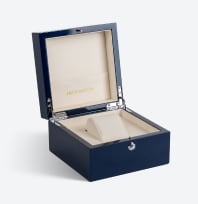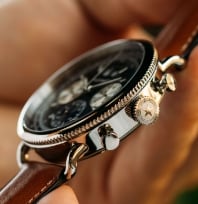The diving watch is a timeless silhouette for men’s watches. Elegant, sleek, and functional, the diving watch has been around since the early 20th century - maybe even earlier.
Classic silhouettes like the Rolex Submariner made the diving watch an instant classic. It was even the watch of choice for Agent Bond in the first ten 007 films.
In this article, we’re going to explain everything you need to know about the diving watch including its history, what makes a watch a “diving” sports watch, and exactly how it works.
History of The Diving Watch
As the name suggests, one of the key differentiators for a diving (also called “dive” or “diver’s”) watch is water resistance or waterproof. This concept isn’t new to modern wrist watches. It may go back as far as the 17th century date window.
There are records of water and dust-resistant watches being made at least in the 19th century for specific individuals. It’s likely these were made for explorers or people who were often braving the elements.
The first concrete example we have of a diving watch comes in 1926. Rolex created a watch case and case back they called the “Oyster.” It featured an airtight seal that, in theory, would prevent any water damage to the timepiece and is submersible.
This was put to the test the very next year. An English swimmer would take the watch in October of 1927 on an attempt to swim across the English channel. After more than 10 hours, the watch held its seal, and even managed to keep accurate time.
Around this same time and in the coming decades, more and more watchmakers began crafting watches made specifically for use in water. As scuba diving became more popular and accessible, more and more people began wanting a watch they could wear with them, even when diving hundreds of meters underwater.
In recent years, there have been more diving watches that are built as pieces of jewelry rather than with function in mind first, but the silhouette of a dive chronometer has remained classic and timeless.
<h3>What Makes a Watch a “Dive” Watch?</h3>
There are a number of criteria that define what a diving watch is. These were put in place by the International Organization for Standardization (ISO) and include several specific features.
First and foremost, the watch must be water-resistant up to at least 100m deep. Many dive watches end up having resistances of 200-300 meters, but at least 100 is required. The watch also has to feature a specified level of magnetic, chemical, and shock resistance.
Also, they must have some way to track diving time. This can be digital, but in mechanical watches, this is usually found in a rotating bezel. This was incredibly useful for divers, as they needed a way to know how long they had been underwater.
In a world before digital clocks and chronograph, being able to rotate your unidirectional bezel to show the minute you went under and track the next 60 minutes was revolutionary.
With that, the watch also has to be easy to read, even in complete darkness. This usually means large minute markings for legibility and luminescent face details. And will look really good with your wetsuit. It is also anti-reflective so that any underwater glares can be avoided.
The last two requirements are a strap or band that can handle at least 45 pounds of force on either attaching point and some way to know the watch is dying on battery-powered watches with power reserve.
There are plenty of “diving watches” on the market that don’t fit these specific criteria. In many cases, it’s more about the look and feel of the watch rather than the specific details. However, nearly every dive watch will at least feature water resistance, a solid, secure strap or band, and a time tracker of some kind.
How Does a Diving Watch Work?
Diving watches come in all different forms and movements, so there is some variety as to how the inner workings of the watch are constructed. In general, you’ll find them in one of three stylings: quartz movement, manual movement, or automatic movement.
Quartz watches are powered by a battery that keeps a quartz crystal in the watch vibrating at a specific frequency. These watches are incredibly accurate and inexpensive to make, but they lack some of the craftsmanship of a mechanical watch.
In contrast, manual watches are completely mechanical. However, they need to be wound regularly to maintain tension on the mainspring and keep the watch running. Automatic watches function pretty much the same way internally, but they include a mechanism for harnessing kinetic energy to keep the watch wound.
If you’re interested in learning more about these watch movements, check out our article on how an automatic watch works[LINK]. With diving watches, though, there are other features to consider.
What Does “Water-Resistant” Mean?
The biggest defining feature of a diving watch is water resistance. Depending on the specific sport watch, this can work in a few different ways, but they all follow the same basic principle.
The sports watch is built with gaskets at every place where water could get in, creating a seal that prevents it from happening. Also, things like a screw-down crown can assist in this as well. That doesn’t solve the problem, though, as diving underwater also creates pressure on the watch.
To help a diving watch withstand the high pressures associated with underwater diving, manufacturers have to take additional steps when making these watches such as a helium release valve or helium escape valve.
For example, you’ll notice that diving watches often have a thick crystal on the face. At Jack Mason, our Seamount Automatic diving watch is made with sapphire crystal, one of the hardest and most durable materials in the world.
We use this in part for scratch resistance, but it also helps ensure that the face will not crack under pressure. In most cases, diving watches are rated for any recreational water activity and light diving, but may not be suitable for a professional scuba diver.
As you go farther down into the water, the pressure gets higher and higher. Although diving watches are rated for a certain distance underwater, watchmakers usually recommend not scuba diving unless the watch is rated specifically for extreme water pressure.
Lab tests and deepsea pressure are not the same, and just because a watch did well in the lab doesn’t mean it will withstand the depth ratings of the deep blue ocean.
What Does a Diving Watch Look Like?
Diving watches come in a variety of different styles, but there are some key features you’ll see across them all.
In general, dive watches are bulkier than other watch styles. Originally, this was due to the need for creating a watertight seal and the extra bulk created by the gaskets inside the watch.
You’ll also notice that many of the best dive watches are made of either metal (like stainless steel case) or a silicone-like material. For obvious reasons, leather straps are not ideal for taking the watch underwater, and using a material like silver or gold gives the watch a natural water-resistance.
In contrast, some watchmakers in recent years have opted for a silicone or rubber strap material for the band, and this is a great choice as well. These bands also give the watch a more casual feel, which is preferable for lots of people.
You’ll also usually find a large watch face with big, luminous hands and details for easy reading underwater. The most classic example of a diving watch is a Rolex Submariner. That’s the look that comes to most people’s minds when they think of a diver’s watch.
You’ll see that the numbers, hands, and face are much bigger than a typical field or dress watch. You’ll also notice that there are luminous elements on different parts of the watch face. This is to make sure that divers can read the watch, even when deep underwater.
There are some diver’s watches that stray far from the classic Submariner-style look, though, opting for something much more digital like a mini limited edition dive computer. These can be great options too, but they don’t offer the same level of class and elegance that you get with more traditional diver watches.
Buy Diving Watches at Jack Mason
At Jack Mason, we offer a collection of diving watches in both quartz and automatic styles. Whether you’re looking for the Bond-style all-metal look, or you want something colorful with a rubber strap, we have something to suit you.
The watch you buy should represent both who you are, as well as the person that you’re becoming. We believe that a man’s watch becomes a part of him over time and that it should last him for years to come.
That’s why all of our watches are crafted with sapphire crystal and either Swiss or Japanese movements, to make sure that you’re getting the highest quality possible. In addition, we don’t think you should have to spend a small fortune to get a luxury watch.
Our watches offer the same quality as other luxury brands like Blancpain, Doxa, Breitling, Oris, Panerai, Tudor, and Heuer - just without the designer price tag. Check out our collections for yourself. We think you’ll be able to find something you love.
Sources:









